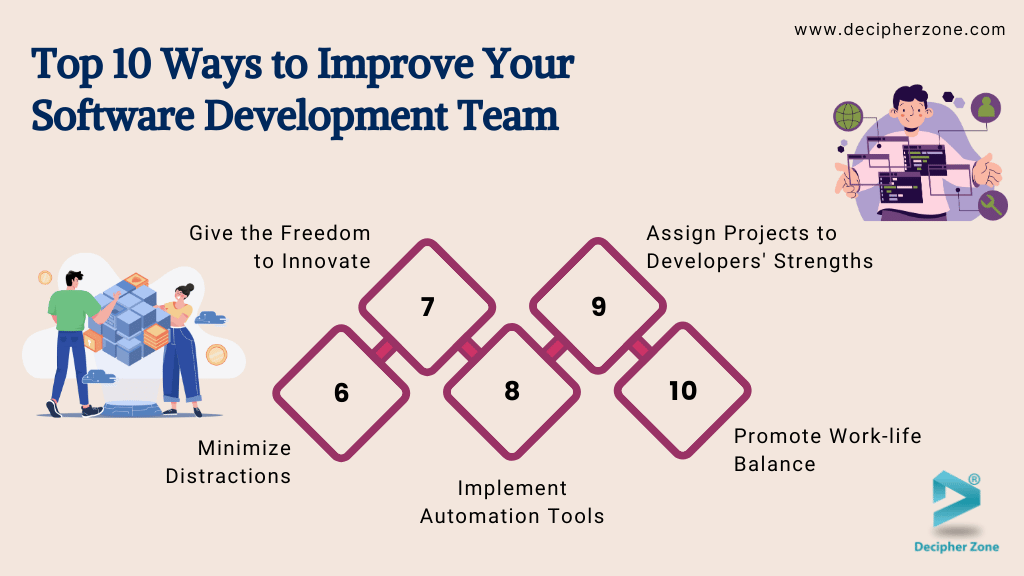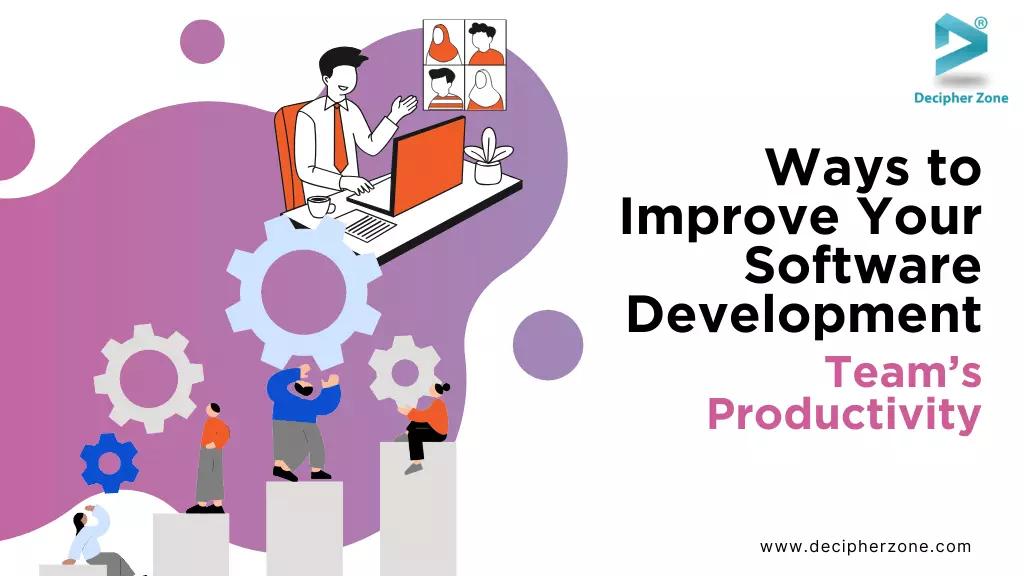Elevate your client relationships by delivering highly efficient software projects with skilled development. This blog provides the most effective strategies to improve the software development team’s productivity.
Read more to explore the impactful approaches that can transform your team’s software developer productivity and drive exceptional results!
Do you know that productive software development teams can be up to 40% more efficient which can enable faster product delivery, reduced costs, and improved client satisfaction?
When productivity thrives, the processes streamline, the quality of the code improves, and team morale skyrockets. But achieving that level of efficiency requires more than just tools and processes. Boosting collaboration, utilizing best practices, and maintaining a clear focus on goals can be effective. But to know what exactly will work continue reading.
This blog focuses on the actionable strategies that can transform how your software development team works. Explore the areas of improvement and tips that are designed to enhance communication and improve the software development team’s productivity.
The responsibility of the software development team is not just about delivering projects—it's about delivering exceptional projects which can only be achieved “when the developers can thrive and perform in their best” environment.
As someone rightly said, “Greate things in business are never done by one person: they are done by a team of enthusiastic individuals.” This perfectly applies to boosting productivity in the software development teams.
Top 10 Strategies to Improve Software Development Team’s Productivity
Below are the top 10 proven strategies you can adopt to elevate your team’s productivity, streamline workflows, and boost a culture of continuous improvement:
1. Clearly Define the Project Scope
Providing clarity can change the aspect of how the software development team works. When developers clearly understand the expectations of the client and the impact of their work, it creates a sense of purpose and motivation, aligning individual efforts with common business goals.
This approach gives developers an idea of what tools to use, what things to keep in mind, and what should not be done. Vague or ambiguous project requirements can create misunderstandings and mislead the developers from the track.
They are expected to make constant improvements and may not be able to see the wider picture.
It is easy for the developers to set the scope for better time management and reduce miscommunication and the need for additional meetings when the project is clearly defined. They can create the roadmap accordingly, set realistic timelines, and allocate resources.
This motivates the software development team and improves their productivity as they can see the direct impact of their work on the project objectives.
2. Implement Agile Methodologies
Agile methodologies focus on continuous improvement and development in short cycles which helps teams deliver high-quality software quickly. For example, Scrum and Kanban are two popular agile methods used in software development.
Scrum divides work into sprints, allowing teams to plan and review their progress regularly. Kanban visualizes the workflow and manages how much work is in progress which helps the team more efficiently and addresses issues as they arise.
By adopting these agile methods, teams can become more productive. They also simplify their processes by removing unnecessary steps, making it easier to respond to customer needs and changes in the market.
Here are some effective strategies for adopting agile methodologies:
-
Define project goals and objectives clearly,
-
Break down work into smaller and more manageable tasks,
-
Focus on organizing tasks according to their significance and influence,
-
Encourage teamwork and open lines of communication among team members,
-
Conduct regular meetings to pinpoint areas where to enhance the processes.
3. Invest in Training & Development
One of the most effective ways to boost productivity is to invest in the team’s training and development. When developers are equipped with the right knowledge, tools, and resources, they can stay ahead of the curve, adapt to the latest technologies, and apply industry best practices.

Training and development go beyond just technical knowledge. The training programs not only sharpen technical skills but also enhance problem-solving and critical thinking.
This can lead to more productive and better results and more effective.
Here are some effective ways to invest in your team's training and development:
-
Provide access to online courses, workshops, certifications,
-
Conduct regular training sessions and encourage attendance at industry events and conferences,
-
Provide guidance, support, and personal development opportunities by offering mentorships and coaching programs.
4. Choose the Right Tools
Choose the right productivity-enhancing tools that are best suited for the task, project, and team’s preferences. Take advantage of tools and technologies like integrated development environments (IDEs), version control systems, project management, and collaboration tools.
These tools allow the developers to automate and set deadlines for the tasks, and clearly define the project requirements. This can impact efficiency, streamline workflow, improve code quality, and facilitate communication within the team.
Here are a few criteria to choose the right productivity tools:
-
Relevance to the project and team’s proficiency,
-
User-friendly interface,
-
Easy customization,
-
Seamless cross-platform integration,
-
Cost-efficient.
5. Encourage Open Communication
Open communication within the development team allows them to share important information on a priority basis and effectively get their work done.
Clear, short, and engaging communication eliminates distractions and frustration for the developers and doesn’t take too much of their time.
A two-way feedback loop is another crucial aspect of improving productivity that allows developers to be accountable, improve skills, and know the areas of improvement.
Here are ways to encourage frequent, clear, and open communication:
-
Regular Scheduled Meetings can be turned out to be hour-long meetings when the agenda is not clear. According to the size of the team and preferences and planning, scheduled meetings can work wonders.
-
Communication tools such as Slack, Trello, or Microsoft Teams allow teams to communicate with each other to make everyone’s work easier and simpler.
-
Encourage team lunch to share updates, blockers, and achievements if any during the development process once or twice a month.
6. Minimize Distractions
Focusing on a single task for an extended period can be quite challenging on its own. To achieve a greater level of concentration and productivity. It’s essential to create a workspace, eliminating any clutter or items on your desk that might divert your attention.
Consider utilizing applications that are designed to block access to distracting websites like any social media platforms of often find it difficult to resist. These tools can serve as an effective barrier that can help you maintain your focus and enhance your productivity.
7. Give the Freedom to Innovate
Allowing developers the freedom to explore and test new ideas is essential enabling a positive experience. This sense of autonomy sparks creativity, boosts a sense of ownership, and encourages developers to seek innovative solutions to complex challenges.
All this can contribute to the ongoing enhancement and evolution of the product.

Developers are more inclined in this kind of culture that prioritizes exploration to embrace learning opportunities related to new technologies, methodologies, and best practices.
Encouraging a supportive atmosphere where experimentation is welcomed and setbacks are viewed as stepping stones to innovation boost developers’ morale and motivation.
This approach of autonomy promotes problem-solving, encourages initiative, and encourages a culture of continuous improvement and learning within the software development team.
8. Implement Automation Tools
With the implementation of automation technologies, the software development team can significantly reduce the burden of manual tasks, eliminate errors, and speed up development cycles.
This is beneficial in areas such as testing, deployment, and code reviews, which often involve repetitive or time-consuming processes.
By automating these routine operations, the software development team can free up valuable time and resources which can allow them to focus on more strategic initiatives and high-value projects that drive innovation and growth.
Here are some effective automation tools worth considering:
-
Continuous Integration and Deployment (CI/CD) Tools such as Jenkins, GitLab CI/CD, or CircleCI.
-
Automated Testing Frameworks such as Selenium, Cypress, JUnit, or TestNG.
-
Code Review Tools such as GitHub Code Review, Crucible, or GitLab Merge Requests.
9. Assign Projects to Developers' Strengths
Developers often experience increased productivity when they are doing something that genuinely captivates their interest. Assigning the work according to their unique strengths and weaknesses, with taking notes of their strengths can be significantly easier.
This tailored approach to task allocation not only enhances overall efficiency but also encourages a more motivated and dynamic work environment, as individual are naturally more inclined to excel when their strengths are matched with the right responsibilities.
This can make a positive impact on their roles, encourage them to think outside the box and come up with creative solutions to challenges, and ultimately make them more efficient in their tasks.
10. Promote Work-life Balance
By promoting work-life balance, the software development team can be more productive and ramp up their team’s efforts to meet deadlines, without burning out their team in the long run.
By creating a healthy and positive environment team members are more likely to stay longer with the organization.
Here are some practical ways to create one:
-
Set fixed hours for work to maintain a routine and work-life balance.
-
Break tasks into manageable pieces with specific deadlines to avoid overwhelm and improve prioritization.
-
Focus on one task at a time to enhance productivity and quality of work by avoiding multitasking.
-
Take short breaks and use them to recharge which can boost concentration.
-
After work, shift your focus away from job-related matters and dedicate time to family, hobbies, and self-care.
Final Thoughts
You might be surprised how changing a few things in the work-life of a software development team can help you be more productive. As software becomes more complex and needs more creativity, it’s important to implement strategies that can deliver your projects faster efficiently.
Remember, productive is not just a one-time task, it’s a journey that needs your attention all the time.

Hire Decipher Zone’s skilled software development team to make it easy to connect with the users which can create a user-satisfying project coming from positive minds.
With the right talent available, we ensure you that our software development team can handle new challenges and provide the most effective software solutions tailored to your unique requirements.
FAQs
-
What are the common challenges to improving software development team productivity?
The common challenges to improving software development team productivity include lack of clarity in project requirements, outdated tools and technologies, poor communication, and team burnout.
-
How can I measure the productivity of my software development team?
Measuring the productivity of the software development team can be done through metrics which include code quality, sprint velocity, on-time delivery, and customer satisfaction.
-
Is remote work beneficial for software development team productivity?
Remote work can be beneficial in various ways including boosting productivity by providing flexibility but requires effective communication tools and clear expectations to succeed.

